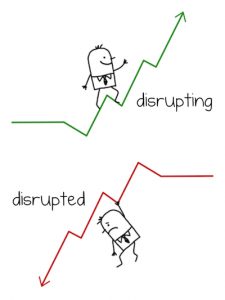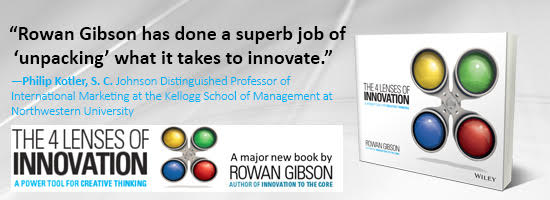Is it REALLY disruptive? It matters.
I called my mob ile phone provider last week with a couple of small issues. The enthusiastic young man on the other end of the phone asked me some basic questions to establish my identity.
ile phone provider last week with a couple of small issues. The enthusiastic young man on the other end of the phone asked me some basic questions to establish my identity.
“What’s your full name?â€
I told him. “Brilliantâ€, came the reply.
“What’s your postcode and the first line of the address?â€
I told him. “Fantasticâ€.
“What are the third and fifth characters of your PIN?â€
I told him. “Amazing.â€
Of course, none of my responses were in any way brilliant, fantastic or amazing. They were very basic, straightforward and not unusual in any way.
I have the impression that the way innovation is described is going the same way, in particular with the use of the term “disruptive.” Somehow, incremental just isn’t good enough anymore. We exaggerate; we have inflation in terminology.
At the recent ISPIM conference, I sat in several presentations ostensibly describing approaches to disruptive innovation when, in reality, it was difficult to see what (a market or a company) was actually being disrupted. They were really talking about breakthrough or radical innovation.
EugeneIvanov’s recent post about the rise of disruptive innovation as a term, conceded that it may be fine to classify innovation into incremental and disruptive, and not wanting to be a terminology cop. Unusually, I’ll disagree with Eugene on this one point (but it is a good article!). I think it is important to use the right terminology for the right type of innovation.
Disruptive innovation, as first coined by Clayton Christensen, describes a process that usually starts off when a smaller company with fewer resources challenges a larger incumbent with innovation, usually at a lower price, that is attractive to customers in overlooked segments. They then move up the value curve, capturing the bulk of the customers.
My issue is not so much with the purist definition of disruptive innovation, a strict interpretation of Christensen’s writings. What bothers me is the use of the term when it is applied to innovation that can only be described as “beyond incrementalâ€. Most people appear to understand the definition of incremental innovation; essentially it’s improving what already exists. There are many ways to do this – improved ingredients, performance, claims, aesthetics, convenience etc. No problem here, then.
The next level of innovation is when new products open up new markets or new customers. Some authors describe this as radical and/or breakthrough, although there is still the occasional example where even this is not appropriate. Consider the expansion of existing products into new geography, is it really radical or breakthrough?
Why does this matter? It’s because the actions a company takes depend very much on the nature of the opportunity or the threat. Imagine you’re on the receiving end of truly disruptive innovation, where the whole price/value structure of your business is likely to change. The response will be totally different to a situation where there’s a new entrant with a better performing product at a similar price.
Equally, if a company is able to truly disrupt a market, their cost structure needs to be totally different. They are likely to take a different approach to generating awareness and acquiring customers. And if you have a radical or breakthrough product that can rapidly take market share, it doesn’t necessarily mean that the market is being disrupted, so the actions will again be different.
As Eugene points out, it’s an interesting challenge for an incumbent player to want to disrupt a market. There are exceptions, such as the situations where disruption is inevitable and they do it to others, rather than have it done to them; coupled with a willingness to self-cannibalize. Again, it’s essential to understand what disruptive actually means, as that understanding will dictate the strategy for the new initiative.
So it is important to correctly define different types of innovation. And we all need to distinguish between what is straightforward but still valuable; and what is brilliant, fantastic and amazing. Just like my mobile phone provider.
image credit: oxfamblogs.org
Wait! Before you go…
Choose how you want the latest innovation content delivered to you:
- Daily — RSS Feed — Email — Twitter — Facebook — Linkedin Today
- Weekly — Email Newsletter — Free Magazine — Linkedin Group
 Kevin McFarthing runs the Innovation Fixer consultancy, helping companies to improve the output and efficiency of their innovation, and to implement Open Innovation. He spent 17 years with Reckitt Benckiser in innovation leadership positions and also has experience in life sciences. Follow @InnovationFixer
Kevin McFarthing runs the Innovation Fixer consultancy, helping companies to improve the output and efficiency of their innovation, and to implement Open Innovation. He spent 17 years with Reckitt Benckiser in innovation leadership positions and also has experience in life sciences. Follow @InnovationFixer
NEVER MISS ANOTHER NEWSLETTER!
LATEST BLOGS
Four ways you can ensure employees take accountability for their work
One of the most important driving factors for any successful business is a high-performing team. Having people working for you…
Read MoreWhat is digital upskilling and why is it important?
Photo by Annie Spratt on Unsplash In a world of business that never stands…
Read More


